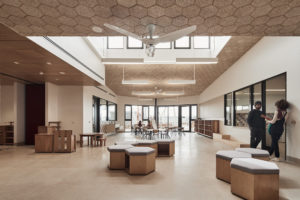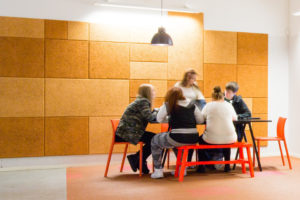Benefits of acoustic design in education and school environments

Aboriginal Community Centre Australia.
The ability to sit still for extended periods of time while listening, especially crucial for students of all ages, is directly influenced by environmental factors such as distracting or irritating sounds. Being able to hear a lecturer or teacher clearly without distraction is a prerequisite for effective learning, yet educational environments commonly face the same challenges as workspaces: excessive noise and poorly designed acoustics.
Teachers risk damaging their vocal cords and hearing when regularly exposed to high sound levels. A large-scale study by the Institute for Interdisciplinary School Research in Germany found that more than 80% of teachers surveyed reported experiencing stress from noise generated by students. Students with special needs and learning disorders such as autism are particularly susceptible to poor acoustics. Many countries mandate the provision of specialised learning environments for students with learning disorders but fail to take into account the impact of sound, which can contribute to anxiety, stress and antisocial tendencies.

Grillska High School in Sweden.
A well designed acoustic environment leads to:
- Improved ability to focus
- Lower cognitive stress
- Fewer distractions and interruptions
- Better information retention
- Improved reading comprehension
- Better short term memory
- Reduced risk of hearing loss
- Minimised vocal strain
- Reduced stress for those with special needs
The primary function of a classroom is to serve as a learning environment where students can receive instruction from their teacher, collaborate with one another, read, and work independently to complete tests and learning exercises. The ability to hear, understand, and focus is critical to the learning process.
Sounds from other students inside the classroom, building appliances like heating, ventilation or air conditioning systems, as well as sounds coming from outside the building like cars or lawnmowers or playgrounds impede students’ ability to hear and concentrate.
One study shows that for a child sitting in the fourth row of an average classroom, speech intelligibility is only 50%. Classrooms with poor acoustics not only have a negative impact on students’ ability to comprehend speech, but they also impact their ability to read, pay attention, concentrate and behave appropriately. These challenges amplify for students with learning disabilities or hearing impairments. Teachers suffer from poor acoustics too. Another study showed that 50% of teachers have suffered vocal damage from talking over classroom noise. Longterm noise exposure can also cause hearing damage and consequences from prolonged stress and job burnout.
Good classroom acoustics benefit everyone. Following improvements to classroom acoustics, teachers have reported higher student engagement and improved learning outcomes. In one study, on-task student behaviour in an acoustically treated classroom increased by 17%. In another study, teacher absence decreased from 15% to 2% post treatment.
Design Strategies
- If possible, during the early stages of building design, add structural buffer zones between noise-sensitive classrooms and areas prone to higher activity and noise levels.
- Reduce reverberation in hallways and other adjacent rooms.
- Add soft and sound absorbing materials to the room such as rugs or carpets, fabric curtains, cork board and ceiling and wall panels.
- Arrange desks at an angle around the room rather than in rows.
- Insulate doors, windows and noisy equipment with sound-blocking material.
- Replace noisy light fixtures.
- Add soft tips or pads to the bottom of tables and chairs.
- Add a speech-reflecting zone with reflective ceiling tiles above the area where the teacher normally stands to make it easier for their voice to reach all corners of the classroom without strain.


NR 35 – usually in libraries, museums, courtrooms, schools, hospitals, operating theatres and wards, flats, hotels, executive offices.